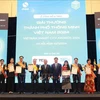Hanoi (VNA) - Deputy Prime Minister Vu Duc Dam has signed Decision No. 569/QĐ-TTg dated May 11 issuing a strategy for scientific-technological development and Innovation until 2030.
IV. MAJOR TASKS, SOLUTIONS FOR SCIENCE, TECHNOLOGY AND INNOVATION DEVELOPMENT
1. Reforming science, technology and innovation mechanisms, and improving the State management of science, technology and innovation
a) Amending and perfecting the legal system on science and technology, and relevant laws to satisfy new requirements set for science, technology and innovation development, and promoting innovation in tandem with science and technology; forming a legal framework for the implementation of pilot, experimental and specific mechanisms for new economic types/models based on science, technology and innovation. Studying the reform of mechanisms, policies and laws on investment, public investment, public procurement, state budget, public assets and tax to encourage and develop science, technology and innovation activities. Perfecting laws on intellectual property, protecting and effectively and rationally utilising intellectual assets created by Vietnam.
b) Comprehensively reforming management activities, implementing science and technology tasks at all levels towards publicity, transparency and objectivity, and simplifying administrative procedures; conducting digital transformation in management processes and database of science, technology and innovation resources; reforming the finance and payment management mechanisms, accepting the principle of risk and delay in science and technology activities; creating favourable conditions for enterprises to engage in the implementation of science and technology tasks; reviewing and amending regulations on the management of science and technology tasks in the direction of removing difficulties and obstacles in the transfer of assets formed in science and technology tasks using state capital.
c) Restructuring science and technology programmes and tasks towards forming product value chains and creating added value. Focusing on developing national products based on new and high technologies to form new industries and new products with high added value, especially in areas of Vietnam’s strength like agriculture, manufacturing and processing, services, information technology, etc. Forming a number of large-scale national science and technology projects and programmes in certain key fields in which Vietnam has strength and potential in order to address especially important long-term problems for national development.
d) Reaching consensus on State management of science, technology and innovation, accelerating innovation in combination with science and technology, raising the efficiency of harmonious coordination in the building and enforcement of mechanisms and policies promoting science, technology and innovation; streamlining the apparatus, focusing on the making of mechanisms, policies and strategic orientations, planning and training plans for science, technology and innovation managers at all levels.
đ) Developing a science and technology forecasting system, building technological development orientations, technology maps and technological reform roadmaps of a number of priority fields, with focus placed on such fields as health care, artificial intelligence, new materials, energy storage and some spheres associated with investment of large enterprises.
e) Measuring and evaluating the efficiency of science, technology and innovation activities conducted by research institutes, universities and enterprises in line with international standards. Sectors and localities integrate science, technology and innovation development targets, including the rate of enterprises with innovation activities, into their development strategies, plans and planning schemes.
2. Building national innovation system
a) Developing a national innovation ecosystem in close association with the region and the world. Developing innovation ecosystems in industry, agriculture and service sectors linked with domestic and global value chains, and sectoral connectivity clusters, in which big enterprises play the central role and lead innovation activities, and State management agencies create a favourable regulation and policy environment to promote linkages between enterprises, research institutes, universities and supporting organisations in research, application and innovation.
b) Developing a system of national innovation centres, innovation centres of sectors and regions and innovative start-up support centres in order to develop and link innovation clusters with hi-tech parks, residential areas, financial centres, venture capital funds, universities and research institutes.
c) Strongly rolling out open innovation platforms and open innovation networks to attract all domestic and foreign investment resources to create new technologies and products, and form new businesses.
d) Increasing linkages among innovation networks, innovative startup networks, innovation centres and scientific research and technological development centres at home and abroad.
đ) Perfecting the organisational system, functions and tasks of, and increasing investment in human resources, finance and infrastructure for public non-business units under the Departments of Science and Technology that perform functions and tasks regarding application and transfer of science and technology and innovation, so that they can become focal points supporting and promoting technology transfer and innovation activities in localities.
3. Attracting and effectively using all investment resources for science, technology and innovation.
a) Ensuring that spending on science, technology and innovation accounts for at least 2% of the total annual state budget expenditure, and gradually increases to meet development requirements of science and technology. Ensuring that expenditures are for right purposes for science, technology and innovation activities.
b) Reviewing and removing barriers and limitations in order to increase the number and scale of science and technology development funds of enterprises; creating the best possible conditions for enterprises to establish investment funds and effectively use them for science, technology and innovation activities; ensuring a law-specified rate of investment set aside for technology development investment funds by state enterprises.
c) Perfecting the public-private partnership mechanism and legal corridors for angel investments, venture capital funds, community investment funds, and digital technology platforms that call for investments, in order to increase investment resources for science, technology and innovation.
4. Developing research institutes, universities and other science and technology organisations into major research subjects
a) Amending and perfecting legal regulations on the autonomy mechanism applicable to public science and technology organisations. Considering the allocation of investment capital to public science and technology organisations based on periodic evaluation of their operational results and efficiency, in association with application of a model under which the State places orders and holds bidding for the implementation of science and technology tasks and the mechanism for setting a package amount to the ultimate product based on outputs; vesting public science and technology organisations with the right to autonomy and accountability for devising their organisational apparatus, recruiting and employing personnel, using budget funds, and performing science and technology tasks.
b) Downsizing the organisational system of public research institutes. Focusing on building a number of research institutes in economic sectors and regions into applied research and innovation centres in service of techno-economic development priorities of economic sectors and regions. Accelerating the merger and transformation into enterprises or equitisation of research institutes that no longer satisfy the conditions on investment priority. Developing and implementing a scheme on transfer of a number of public research institutes engaged in basic research to universities and academies in order to promote the research and training linkage. Improving the capacity of policy research organisations of sectors and localities.
c) Implementing policies and solutions for universities to truly become scientific research and technological development centres, and a source of knowledge for innovation activities. Developing strong research groups and a number of international-level research groups; graduate and postgraduate students are an important force in scientific research and technological development; linking postgraduate training with research topics and projects; encouraging and supporting the establishment of research centres and the transfer of intellectual assets. Studying a mechanism that allows researchers and lecturers to participate in the establishment of innovative start-up businesses from scientific research and technological development results. Building Vietnam National University, Hanoi and Vietnam National University, Ho Chi Minh City and a number of technology universities into nucleus, core and leading institutions of the Vietnamese educational system, which will reach the advanced level and be among the top group in Asia in high-quality human resources training, scientific research and innovation. Turning regional universities into centres of human resources training, research and knowledge transfer serving innovation in regions and localities.
d) Concentrating on developing a number of science and technology organisations of international and regional standards. Evaluating and announcing the rankings and selection of potential science and technology organisations for intensive development investment, and adopting priority mechanisms and policies for placing orders and assigning scientific and technological tasks. Building the Vietnam Academy of Science and Technology and the Vietnam Academy of Social Sciences into the foundations and pillars of Vietnam's science and technology. Encouraging investment in the form of public-private partnership with large enterprises and foreign partners in order to develop outstanding technology centres in universities and research institutes; attracting multinational corporations to establish scientific research and technological development facilities and international innovation centres in Vietnam.
(to be continued)


























